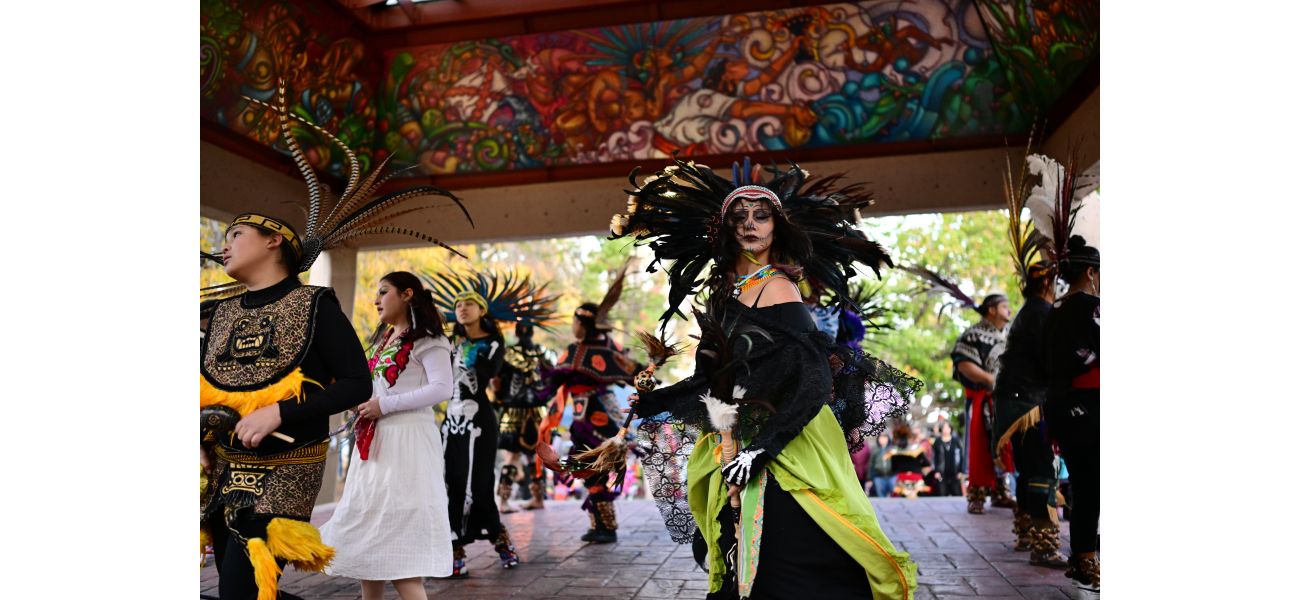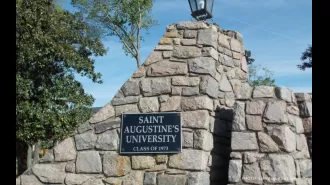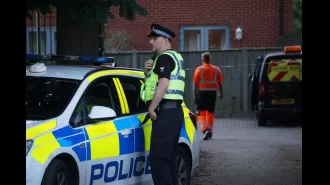Sunnyside in Denver, once a strong Latino community, is now declining, but some residents still remain in the area.
Gonzales explains that people in Denver have been forced out and unable to afford living there due to gentrification's negative impact on their community.
November 16th 2024.

Tulin Yarmon and her granddaughter Avani spent a lovely afternoon at La Raza Park in northwest Denver, honoring their deceased loved ones on Día de los Muertos. The park was adorned with an ofrenda, a traditional altar for the occasion. This annual event holds a special place in the hearts of the pair, as they also built their own ofrenda at home and got dressed up in costumes and painted their faces before arriving at the park. The event has been a longstanding tradition in the Sunnyside neighborhood, which is known for its strong Latino roots.
Despite not living in the neighborhood herself, Yarmon's family has deep ties to the area. Her grandmother-in-law used to live in Sunnyside, off West 38th Avenue and Wyandot Street. However, Yarmon has noticed that the neighborhood has undergone some significant changes over the years. "If you go down that street, I don't think there's a single Hispanic left on the block," she shared. "They knocked down the traditional bungalows, and they built those two-story boxes." Like many other Latino community leaders, residents, and those with ties to the neighborhood, Yarmon mourns the loss of Sunnyside's cultural identity as gentrification continues to shape the area.
Sunnyside has always been a hub for Denver's Latino community, along with other neighborhoods such as Westwood, Auraria, and La Alma Lincoln Park. However, the demographics of these areas have been shifting in recent years. According to Sunnyside United Neighbors, in 2000, 72% of the neighborhood's population was Latino. But in just 22 years, that number has dropped to 37%, as reported by census data.
One of the major effects of gentrification is the steep rise in home prices. In 2012, the median residential property value in Sunnyside was reported to be $208,300. By 2022, that number had tripled to $711,450. "Sunnyside traditionally has always been one of the more affordable areas in northwest Denver," explained realtor Amy Berglund. "But in the last few years, its commercial corridors have boomed, and new restaurants and businesses have sprung up." This has resulted in a surge of interest and development in the neighborhood, leading to a significant increase in home prices.
One of the main draws for buyers is the generous yard space and zoning for accessory dwelling units (ADUs) and duplexes in Sunnyside. "Developers have really taken an interest in Sunnyside over the last decade, partly because the land was more affordable," added Berglund. Today, home prices in the neighborhood range from $500,000 for fixer-uppers to a staggering $1.8 million for new builds. Additionally, the opening of the Regional Transportation District's 41st & Fox commuter rail station has made Sunnyside even more desirable, with developers taking advantage of denser zoning near the station to build apartments.
However, for many longtime residents like Yarmon, these changes have resulted in being priced out of their own neighborhood. "As people come and go on the Northside," she explained, "I'm still confident that Denver's Latinos are persevering in the two-mile area between La Raza Park and César Chávez Park in neighboring Berkeley." She hopes that the Hispanic cultural traditions in the area will continue for generations to come and makes it a point to bring her granddaughter to Día de los Muertos every year to pass down their family's heritage.
Sunnyside has a long history of welcoming immigrant populations, starting with Irish immigrants in the 1860s and 1870s, followed by Italian immigrants in the following decades. The neighborhood also saw an influx of Latino residents in the early 20th century, who worked at sugar companies in the area. From the 1960s to the 1970s, the Latino population in Sunnyside doubled, according to Sunnyside United Neighbors.
Unfortunately, the Latino majority that once thrived in the neighborhood has significantly dwindled in recent years. "In Denver in particular," lamented Rudy Gonzales, President and CEO of the Denver nonprofit Servicios de La Raza, "we've been pushed out, we've been priced out. Gentrification has really harmed us and our community." Gonzales, who previously lived in close proximity to Sunnyside, has seen firsthand the changes in the neighborhood over the years. He believes that the Latino community has been hit hardest by gentrification, as many are forced to leave their homes and the neighborhoods they grew up in.
Diane Medina, who has lived in Sunnyside for over four decades, has also felt the effects of gentrification. She has rejected numerous offers to buy her home, determined to stay in the neighborhood where she grew up. "It's going to probably look like some place that I don't want it to look like," she said, envisioning the future of Sunnyside. "But I'm going to still be there." Despite the changes, she remains committed to her community and continues to attend Día de los Muertos every year, keeping her family's cultural traditions alive.
As the neighborhood continues to evolve, the once familiar faces in Sunnyside have become few and far between. La Raza Park, once a bustling green space filled with children, is now mostly frequented by pet owners walking their dogs. "You had more people that looked like you. You went to school with folks that lived by you," recalled Medina. "You were familiar, and that's what gave the sense of community." But with each passing day, she feels like more of a stranger in her own neighborhood. "It happens gradually," she said, "and you don't really notice as much until you're feeling like you're a stranger in your own community." However, despite the changes, Medina remains steadfast in her love for Sunnyside and her determination to stay in the neighborhood she has called home for so long.
Tulin Yarmon and her granddaughter Avani, who is 12 years old, were enjoying the sweet aroma of incense as it gently wafted over them from an ofrenda, a beautiful altar dedicated to honoring their deceased loved ones. This special altar had been set up in Denver's La Raza Park, in celebration of Día de los Muertos, or Day of the Dead.
As a cherished tradition in Sunnyside for many years, Día de los Muertos holds a special place in the hearts of the community. Tulin and Avani had also created their own ofrenda at home, pouring their love and memories into every detail. They had even dressed up in costumes and painted their faces before heading to the annual event in their beloved city's Northside.
Tulin, who is 56 years old, may not live in the neighborhood, but her family has a strong connection to the north and west areas of Denver. Her grandmother-in-law used to reside in Sunnyside, on West 38th Avenue and Wyandot Street, and the memories of that time still hold a special place in Tulin's heart.
However, as Tulin sadly recalls, the neighborhood has undergone changes over the years. She shares, "If you go down that street, I don't think there's a single Hispanic left on the block. They knocked down the traditional bungalows and built those two-story boxes." It's a common tale of gentrification, where the traditional homes of the community are replaced by modern, expensive dwellings.
And Sunnyside is not the only neighborhood experiencing this shift. The demographics of nearby areas like Westwood, Auraria, and La Alma Lincoln Park are also changing. The Latino community leaders, residents, and those who have family ties to the Northside are mourning these changes, as they are a reminder of the area's strong Latino heritage.
As they walked through the streets, Tulin and Avani were greeted by the vibrant dancers of GRUPO TLALOC Danza Azteca, who were marching as part of the Día de los Muertos celebration. The streets were bustling with people, and Tulin couldn't help but notice the numerous new duplexes and townhouses that had sprung up in place of the single-family homes that once stood there.
According to realtor Amy Berglund, Sunnyside has always been known as one of the more affordable neighborhoods in northwest Denver. However, in recent years, the commercial corridors have been booming, thanks to popular restaurants like Bacon Social House and The Radiator. And with new developments, the neighborhood has become increasingly popular among prospective buyers.
But with this popularity comes a steep price. The median residential property value in Sunnyside has more than tripled since 2012 and now ranges from $500,000 to $1.8 million. The new Regional Transportation District's commuter rail station at 41st & Fox has also contributed to the rising interest in the area, as it provides a convenient link to downtown on the G and B lines.
Unfortunately, these changes have also resulted in the displacement of the Latino community. As community leader Rudy Gonzales laments, "In Denver, we've been pushed out and priced out. Gentrification has really harmed us and our community." Gonzales, who used to live in the neighborhood, has watched as it slowly transformed over the years.
Diane Medina, who has lived in Sunnyside for 44 years, also shares a similar sentiment. She remembers a time when the neighborhood was filled with familiar faces and a strong sense of community. But as more and more people have been priced out, Medina has noticed a shift in the neighborhood's demographics. She now feels like a stranger in her own community.
But despite the changes, Medina remains determined to stay in the neighborhood she has called home for so long. She has rejected numerous offers to buy her home and plans to continue attending Día de los Muertos celebrations every year, in honor of her culture and heritage.
As Tulin and Avani walked through the streets, enjoying the festivities and remembering their loved ones, Tulin couldn't help but feel hopeful for the future. She shares, "I hope that [Avani] comes here and brings her children and her grandchildren, regardless of how gentrified we become." And with that hope in her heart, Tulin knows that the Latino community will continue to persevere in the Northside, keeping their traditions alive for generations to come.
Despite not living in the neighborhood herself, Yarmon's family has deep ties to the area. Her grandmother-in-law used to live in Sunnyside, off West 38th Avenue and Wyandot Street. However, Yarmon has noticed that the neighborhood has undergone some significant changes over the years. "If you go down that street, I don't think there's a single Hispanic left on the block," she shared. "They knocked down the traditional bungalows, and they built those two-story boxes." Like many other Latino community leaders, residents, and those with ties to the neighborhood, Yarmon mourns the loss of Sunnyside's cultural identity as gentrification continues to shape the area.
Sunnyside has always been a hub for Denver's Latino community, along with other neighborhoods such as Westwood, Auraria, and La Alma Lincoln Park. However, the demographics of these areas have been shifting in recent years. According to Sunnyside United Neighbors, in 2000, 72% of the neighborhood's population was Latino. But in just 22 years, that number has dropped to 37%, as reported by census data.
One of the major effects of gentrification is the steep rise in home prices. In 2012, the median residential property value in Sunnyside was reported to be $208,300. By 2022, that number had tripled to $711,450. "Sunnyside traditionally has always been one of the more affordable areas in northwest Denver," explained realtor Amy Berglund. "But in the last few years, its commercial corridors have boomed, and new restaurants and businesses have sprung up." This has resulted in a surge of interest and development in the neighborhood, leading to a significant increase in home prices.
One of the main draws for buyers is the generous yard space and zoning for accessory dwelling units (ADUs) and duplexes in Sunnyside. "Developers have really taken an interest in Sunnyside over the last decade, partly because the land was more affordable," added Berglund. Today, home prices in the neighborhood range from $500,000 for fixer-uppers to a staggering $1.8 million for new builds. Additionally, the opening of the Regional Transportation District's 41st & Fox commuter rail station has made Sunnyside even more desirable, with developers taking advantage of denser zoning near the station to build apartments.
However, for many longtime residents like Yarmon, these changes have resulted in being priced out of their own neighborhood. "As people come and go on the Northside," she explained, "I'm still confident that Denver's Latinos are persevering in the two-mile area between La Raza Park and César Chávez Park in neighboring Berkeley." She hopes that the Hispanic cultural traditions in the area will continue for generations to come and makes it a point to bring her granddaughter to Día de los Muertos every year to pass down their family's heritage.
Sunnyside has a long history of welcoming immigrant populations, starting with Irish immigrants in the 1860s and 1870s, followed by Italian immigrants in the following decades. The neighborhood also saw an influx of Latino residents in the early 20th century, who worked at sugar companies in the area. From the 1960s to the 1970s, the Latino population in Sunnyside doubled, according to Sunnyside United Neighbors.
Unfortunately, the Latino majority that once thrived in the neighborhood has significantly dwindled in recent years. "In Denver in particular," lamented Rudy Gonzales, President and CEO of the Denver nonprofit Servicios de La Raza, "we've been pushed out, we've been priced out. Gentrification has really harmed us and our community." Gonzales, who previously lived in close proximity to Sunnyside, has seen firsthand the changes in the neighborhood over the years. He believes that the Latino community has been hit hardest by gentrification, as many are forced to leave their homes and the neighborhoods they grew up in.
Diane Medina, who has lived in Sunnyside for over four decades, has also felt the effects of gentrification. She has rejected numerous offers to buy her home, determined to stay in the neighborhood where she grew up. "It's going to probably look like some place that I don't want it to look like," she said, envisioning the future of Sunnyside. "But I'm going to still be there." Despite the changes, she remains committed to her community and continues to attend Día de los Muertos every year, keeping her family's cultural traditions alive.
As the neighborhood continues to evolve, the once familiar faces in Sunnyside have become few and far between. La Raza Park, once a bustling green space filled with children, is now mostly frequented by pet owners walking their dogs. "You had more people that looked like you. You went to school with folks that lived by you," recalled Medina. "You were familiar, and that's what gave the sense of community." But with each passing day, she feels like more of a stranger in her own neighborhood. "It happens gradually," she said, "and you don't really notice as much until you're feeling like you're a stranger in your own community." However, despite the changes, Medina remains steadfast in her love for Sunnyside and her determination to stay in the neighborhood she has called home for so long.
Tulin Yarmon and her granddaughter Avani, who is 12 years old, were enjoying the sweet aroma of incense as it gently wafted over them from an ofrenda, a beautiful altar dedicated to honoring their deceased loved ones. This special altar had been set up in Denver's La Raza Park, in celebration of Día de los Muertos, or Day of the Dead.
As a cherished tradition in Sunnyside for many years, Día de los Muertos holds a special place in the hearts of the community. Tulin and Avani had also created their own ofrenda at home, pouring their love and memories into every detail. They had even dressed up in costumes and painted their faces before heading to the annual event in their beloved city's Northside.
Tulin, who is 56 years old, may not live in the neighborhood, but her family has a strong connection to the north and west areas of Denver. Her grandmother-in-law used to reside in Sunnyside, on West 38th Avenue and Wyandot Street, and the memories of that time still hold a special place in Tulin's heart.
However, as Tulin sadly recalls, the neighborhood has undergone changes over the years. She shares, "If you go down that street, I don't think there's a single Hispanic left on the block. They knocked down the traditional bungalows and built those two-story boxes." It's a common tale of gentrification, where the traditional homes of the community are replaced by modern, expensive dwellings.
And Sunnyside is not the only neighborhood experiencing this shift. The demographics of nearby areas like Westwood, Auraria, and La Alma Lincoln Park are also changing. The Latino community leaders, residents, and those who have family ties to the Northside are mourning these changes, as they are a reminder of the area's strong Latino heritage.
As they walked through the streets, Tulin and Avani were greeted by the vibrant dancers of GRUPO TLALOC Danza Azteca, who were marching as part of the Día de los Muertos celebration. The streets were bustling with people, and Tulin couldn't help but notice the numerous new duplexes and townhouses that had sprung up in place of the single-family homes that once stood there.
According to realtor Amy Berglund, Sunnyside has always been known as one of the more affordable neighborhoods in northwest Denver. However, in recent years, the commercial corridors have been booming, thanks to popular restaurants like Bacon Social House and The Radiator. And with new developments, the neighborhood has become increasingly popular among prospective buyers.
But with this popularity comes a steep price. The median residential property value in Sunnyside has more than tripled since 2012 and now ranges from $500,000 to $1.8 million. The new Regional Transportation District's commuter rail station at 41st & Fox has also contributed to the rising interest in the area, as it provides a convenient link to downtown on the G and B lines.
Unfortunately, these changes have also resulted in the displacement of the Latino community. As community leader Rudy Gonzales laments, "In Denver, we've been pushed out and priced out. Gentrification has really harmed us and our community." Gonzales, who used to live in the neighborhood, has watched as it slowly transformed over the years.
Diane Medina, who has lived in Sunnyside for 44 years, also shares a similar sentiment. She remembers a time when the neighborhood was filled with familiar faces and a strong sense of community. But as more and more people have been priced out, Medina has noticed a shift in the neighborhood's demographics. She now feels like a stranger in her own community.
But despite the changes, Medina remains determined to stay in the neighborhood she has called home for so long. She has rejected numerous offers to buy her home and plans to continue attending Día de los Muertos celebrations every year, in honor of her culture and heritage.
As Tulin and Avani walked through the streets, enjoying the festivities and remembering their loved ones, Tulin couldn't help but feel hopeful for the future. She shares, "I hope that [Avani] comes here and brings her children and her grandchildren, regardless of how gentrified we become." And with that hope in her heart, Tulin knows that the Latino community will continue to persevere in the Northside, keeping their traditions alive for generations to come.
[This article has been trending online recently and has been generated with AI. Your feed is customized.]
[Generative AI is experimental.]
0
0
Submit Comment





